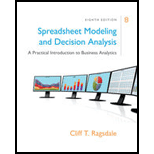
Spreadsheet Modeling & Decision Analysis: A Practical Introduction To Business Analytics, Loose-leaf Version
8th Edition
ISBN: 9781337274852
Author: Ragsdale, Cliff
Publisher: South-Western College Pub
expand_more
expand_more
format_list_bulleted
Concept explainers
Question
error_outline
This textbook solution is under construction.
Students have asked these similar questions
Question 5
Give two common approaches to gaining a focus on the data (2 marks)
A bar chart is similar to a histogram. Yes or No Discuss
A bar chart is similar to a histogram. Yes or No Discuss
Knowledge Booster
Learn more about
Need a deep-dive on the concept behind this application? Look no further. Learn more about this topic, management and related others by exploring similar questions and additional content below.Similar questions
- Are frequency distributions the only methods that researchers use to organize data? Yes or No Discussarrow_forwardAre frequency distributions the only methods that researchers use to organize data? Yes or No Discussarrow_forwardAre frequency distributions useful to organize data? Please discuss and provide examples where necessary.arrow_forward
- 6. The first step in starting the research process is.. a) Searching for solutions to the problem b) Identification of the problem c) Survey of the related literature d) Searching sources of information to locate problem 7. Which of the following is NOT a form of nonrandom sampling? a) Quota sampling b) Purposive sampling c) Snowball sampling d) Convenience sampling 8. The ability to generalize the results of a study is related to.... a) External validity b) Manipulation c) Internal validity d) Predictive validity 9. Which of the following is of least concern to a qualitative researcher? a) trustworthiness b) Validity. c) Generalizability d) Understanding 10. The most important consideration in selecting a sample is that it should be........ a) Selected from a large number of individuals or elements b) Selected from the population by means of a table of random numbers c) Made up of a large number of subjects d) Representative of the populationarrow_forwardQuestion 4 Outline some suggestions regarding how to word interview questions. (10 marks)arrow_forwardQuestion 3 But even with the best survey and the best results, action won't happen on its own. Your task as a business owner is to make sure the results are used. What can you do to make this happen? (8 marks)arrow_forward
- Outline the steps to follow when starting to create the business report. (6 marks)arrow_forward7. Which of the following is NOT a form of nonrandom sampling? a) Quota sampling b) Purposive sampling c) Snowball sampling d) Convenience sampling 8. The ability to generalize the results of a study is related to......... a) External validity b) Manipulation c) Internal validity d) Predictive validity 9. Which of the following is of least concern to a qualitative researcher? a) trustworthiness b) Validity c) Generalizability d) Understanding 10. The most important consideration in selecting a sample is that it should be.... a) Selected from a large number of individuals or elements b) Selected from the population by means of a table of random numbers c) Made up of a large number of subjects d) Representative of the populationarrow_forward6. The first step in starting the research process is.. a) Searching for solutions to the problem b) Identification of the problem c) Survey of the related literature d) Searching sources of information to locate problem 7. Which of the following is NOT a form of nonrandom sampling? a) Quota sampling b) Purposive sampling c) Snowball sampling d) Convenience sampling 8. The ability to generalize the results of a study is related to.... a) External validity b) Manipulation c) Internal validity d) Predictive validity 9. Which of the following is of least concern to a qualitative researcher? a) trustworthiness b) Validity. c) Generalizability d) Understanding 10. The most important consideration in selecting a sample is that it should be........ a) Selected from a large number of individuals or elements b) Selected from the population by means of a table of random numbers c) Made up of a large number of subjects d) Representative of the populationarrow_forward
- 1. In which section of the research plan are the research participants described in details? a) Introduction b) Data Analysis c) Discussion d) Methodology 2. The feasibility of a research study should be considered in light of....... a) All of the above b) Potential ethical concerns c) Skills required of the researcher d) Cost and time required to conduct the study 3. Which of the following best describes quantitative research? a) Research that is exploratory b) An attempt to confirm the researcher's hypothesis c) The collection of non-numeric data d) Research that attempts to generate a new theory 4. The Qualitative research is often exploratory and has all of the following characteristics Except a) It is typically used when a great deal is already known about the topic of interest b) It relies on the collection of non-numerical data such as words and pictures c) It is used to generate hypotheses and develop theory about phenomena in the world d) It uses the inductive scientific…arrow_forwardExplain the attributes of an effective corporate leader.arrow_forwardBriefly discuss how corporate governance may enhance corporate social responsibilities. Discuss how corporate governance can enhance corporate social responsibilities.arrow_forward
arrow_back_ios
SEE MORE QUESTIONS
arrow_forward_ios
Recommended textbooks for you
 Practical Management ScienceOperations ManagementISBN:9781337406659Author:WINSTON, Wayne L.Publisher:Cengage,
Practical Management ScienceOperations ManagementISBN:9781337406659Author:WINSTON, Wayne L.Publisher:Cengage,

Practical Management Science
Operations Management
ISBN:9781337406659
Author:WINSTON, Wayne L.
Publisher:Cengage,
Inventory Management | Concepts, Examples and Solved Problems; Author: Dr. Bharatendra Rai;https://www.youtube.com/watch?v=2n9NLZTIlz8;License: Standard YouTube License, CC-BY